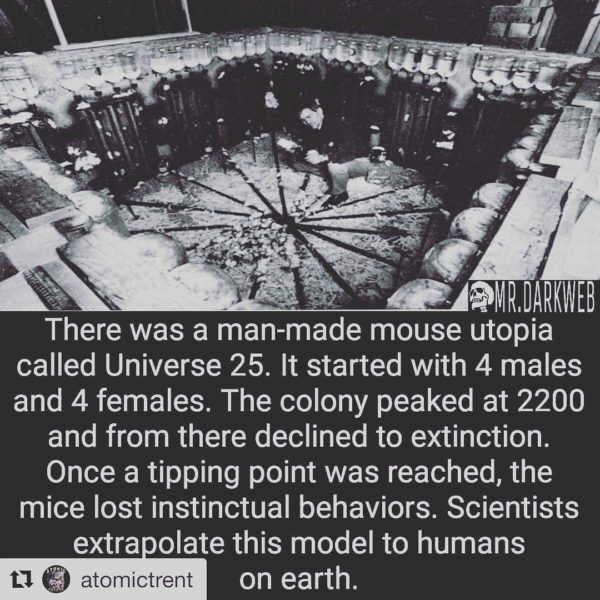

John Calhoun studied behavior during overcrowding in mice and rats.
For io9, Esther Inglis-Arkell writes about Calhoun’s twenty-fifth habitat and the experiment that followed:
At the peak population, most mice spent every living second in the company of hundreds of other mice. They gathered in the main squares, waiting to be fed and occasionally attacking each other.
Few females carried pregnancies to term, and the ones that did seemed to simply forget about their babies. They’d move half their litter away from danger and forget the rest. Sometimes they’d drop and abandon a baby while they were carrying it.
The few secluded spaces housed a population Calhoun called, “the beautiful ones.” Generally guarded by one male, the females—and few males—inside the space didn’t breed or fight or do anything but eat and groom and sleep.
When the population started declining the beautiful ones were spared from violence and death, but had completely lost touch with social behaviors, including having sex or caring for their young.
Calhoun’s experiments, which started with rats an outdoor pen and moved on to mice at the National Institute of Mental Health during the early 1960s, were interpreted at the time as evidence of what could happen in an overpopulated world. The unusual behaviors he observed he dubbed “behavioral sinks.”
After Calhoun wrote about his findings in a 1962 issue of Scientific American, that term caught on in popular culture, according to a paper published in the Journal of Social History.
The work tapped into the era’s feeling of dread that crowded urban areas heralded the risk of moral decay — and events like the murder of Kitty Genovese (though it was misreported) only served to intensify the worry.
A host of science fiction works — books like Soylent Green, comics like 2000AD — played on Calhoun’s ideas and those of his contemporaries. The work also inspired the 1971 children’s book Mrs. Frisby and the Rats of NIMH, which was also made into a 1982 film The Secret of NIMH, notes the National Institutes of Health.
Now, interpretations of Calhoun’s work have changed.
Inglis-Arkell explains that the habitats he created weren’t really overcrowded, but that isolation enabled aggressive mice to stake out territory and isolate the beautiful ones.
She writes, “Instead of a population problem, one could argue that Universe 25 had a fair distribution problem.”
But we can take comfort in the face that humans are not mice. The NIH Record spoke to medical historian Edmund Ramsden about Calhoun’s work:
Ultimately, “[r]ats may suffer from crowding; human beings can cope,” Ramdsen says. “Calhoun’s research was seen not only as questionable, but also as dangerous.”
Another researcher, Jonathan Freedman, turned to studying actual people — they were just high school and university students, but definitely human.
His work suggested a different interpretation.
Moral decay could arise “not from density, but from excessive social interaction,” Ramsden says.
“Not all of Calhoun’s rats had gone berserk.
Those who managed to control space led relatively normal lives.”
Calhoun’s work didn’t give us answers, but it is rare that any single study or series of studies can draw definite conclusions. Instead, we have ideas and some strange footage of old experiments about mouse utopias:
more recommended stories
 Fentanyl Seizures at Border Continue to Spike, Making San Diego a National Epicenter for Fentanyl Trafficking
Fentanyl Seizures at Border Continue to Spike, Making San Diego a National Epicenter for Fentanyl TraffickingFentanyl Seizures at Border Continue to.
 Utah Man Sentenced for Hate Crime Attack of Three Men
Utah Man Sentenced for Hate Crime Attack of Three MenTuesday, August 8, 2023 A.
 Green Energy Company Biden Hosted At White House Files For Bankruptcy
Green Energy Company Biden Hosted At White House Files For BankruptcyAug 7 (Reuters) – Electric-vehicle parts.
 Former ABC News Reporter Who “Debunked” Pizzagate Pleads Guilty of Possessing Child pδrn
Former ABC News Reporter Who “Debunked” Pizzagate Pleads Guilty of Possessing Child pδrnFriday, July 21, 2023 A former.
 Six Harvard Medical School and an Arkansas mortuary Charged With Trafficking In Stolen Human Remains
Six Harvard Medical School and an Arkansas mortuary Charged With Trafficking In Stolen Human RemainsSCRANTON – The United States.
 Over 300 People Facing Federal Charges For Crimes Committed During Nationwide Demonstrations
Over 300 People Facing Federal Charges For Crimes Committed During Nationwide DemonstrationsThe Department of Justice announced that.
